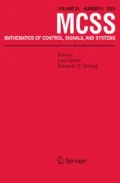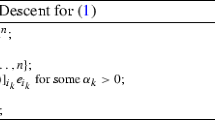Abstract
When an orthogonal projection is to be computed using data acquired by distributed sensors, it is often necessary to process each sensor's data locally and then transmit the results to a central facility for final processing. The most efficient way to do this is to compute oblique projections locally. This choice makes the final processing a matter of summing the oblique projections. In this paper we derive new formulas, and iterative algorithms and associated error bounds, for oblique projections in arbitrary Hilbert spaces.
Similar content being viewed by others
References
V. M. Adamyan and D. Z. Arov, A general solution of a problem in linear prediction of stationary processes,Theory Probab. Appl.,13 (1968), 394–407.
S.N. Afriat, Orthogonal and oblique projectors and the characteristics of pairs of vector spaces,Math. Proc. Cambridge Philos. Soc.,53 (1957), 800–816.
N. Aronszajn, Theory of reproducing kernels,Trans. Amer. Math. Soc.,68 (1950), 337–404.
T.-S. Chang, Comments on “Computation and transmission requirements for a decentralized linear-quadratic-Gaussian control problem”,IEEE Trans. Automat. Control,25 (1980), 609–610.
D. Del Pasqua, On a concept of disjoint linear manifolds in a Banach space,Rend. Mat.,13 (1955), 406–422.
U.B. Desai and H.L. Weinert, A vector space approach to the indefiniteLQR problem,Internat. J. Control,39 (1984), 507–515.
T.N.E. Greville, Solutions of the matrix equationXAX=X, and relations between oblique and orthogonal projectors,SIAM J. Appl. Math.,26 (1974), 828–832.
P.R. Halmos,Finite Dimensional Vector Spaces, Springer-Verlag, New York, 1974.
I. Halperin, The product of projection operators,Acta Sci. Math.,23 (1962), 96–99.
C. Hamaker and D.C. Solmon, The angles between the null spaces of X-rays,J. Math. Anal. Appl.,62 (1978), 1–23.
D.C. Hyland and D.S. Bernstein, The optimal projection equations for model reduction and the relationships among the methods of Wilson, Skelton and Moore,IEEE Trans. Automat. Control,30 (1985), 1201–1211.
T. Kato,A Short Introduction to Perturbation Theory for Linear Operators, Springer-Verlag, New York, 1982.
S. Kayalar and H.L. Weinert, Error bounds for the method of alternating projections,Math. Control Signals Systems,1 (1988), 43–59.
J.D. Klein and B.W. Dickinson, A normalized ladder form of the residual energy ratio algorithm for PARCOR estimation via projections,IEEE Trans. Automat. Control,28 (1983), 943–952.
E.R. Lorch, On a calculus of operators in reflexive vector spaces,Trans. Amer. Math. Soc.,45 (1939), 217–234.
V.E. Lyantse, Some properties of idempotent operators,Teoret, i Prikl. Mat.,1 (1958), 16–22.
F.J. Murray, On complementary manifolds and projections inL p andl p ,Trans. Amer. Math. Soc.,41 (1937), 138–152.
M. Pavon, New results on the interpolation problem for continuous-time stationary-increments processes,SIAM J. Control Optim.,22 (1984), 133–142.
L.R. Riddle and H.L. Weinert, Fast algorithms for the reconstruction of images from hyperbolic systems,Proceedings of the 25th Conference on Decision and Control, 1986, pp. 173–178.
Y. Saad, The Lanczos biorthogonalization algorithm and other oblique projection methods for solving large unsymmetric systems,SIAM J. Numer. Anal.,19 (1982), 485–506.
H. Salehi, On the alternating projections theorem and bivariate stationary stochastic processes,Trans. Amer. Math. Soc.,128 (1967), 121–134.
C. Samson, A unified treatment of fast algorithms for identification,Internat. J. Control,35 (1982), 909–934.
J.L. Speyer, Computation and transmission requirements for a decentralized linear-quadratic-Gaussian control problem,IEEE Trans. Automat. Control,24 (1979), 266–269.
K. Takeuchi, H. Yanai, and B.N. Mukherjee,The Foundations of Multivariate Analysis, Wiley, New York, 1982.
H.L. Weinert and E.S. Chornoboy, Smoothing with blackouts, inModelling and Application of Stochastic Processes (U.B. Desai, ed.), pp. 273–278, Kluwer, Boston, 1986.
D.C. Youla, Generalized image restoration by the method of alternating projections,IEEE Trans. Circuits and Systems,25 (1978), 694–702.
Author information
Authors and Affiliations
Additional information
This work was supported by the Office of Naval Research under Contract N00014-85-K-0255.
Rights and permissions
About this article
Cite this article
Kayalar, S., Weinert, H.L. Oblique projections: Formulas, algorithms, and error bounds. Math. Control Signal Systems 2, 33–45 (1989). https://doi.org/10.1007/BF02551360
Received:
Revised:
Issue Date:
DOI: https://doi.org/10.1007/BF02551360




